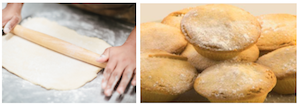Don’t Waste Any Dough: Making Fruit Pie
(based off of Bowland Math’s Assessment Task “Fruit Pies”)

Standards:
CCSS.MATH.CONTENT.7.G.B.4 Know the formulas for the area and circumference of a circle and use them to solve problems; give an informal derivation of the relationship between the circumference and area of a circle.
CCSS.MATH.PRACTICE.MP1 Make sense of problems and persevere in solving them.
CCSS.MATH.PRACTICE.MP2 Reason abstractly and quantitatively.
CCSS.MATH.PRACTICE.MP4 Model with mathematics.
Introduction:
Introduce students to the process of making a mini-fruit pie and the constraints of the problem:
-
A complete pie requires two pastry circles: one with a 10 cm diameter, and one with a 6 cm diameter.
-
The dough begins as a rectangular sheet with the dimensions 60 cm by 30 cm.
-
After she cuts out the first set of circles, she balls up the leftover dough and rerolls it into a smaller rectangle (but she will only use the leftover pastry in this way once).
-
Note: because the dough is rolled so thin, the thickness of the dough will not be included in the calculations for the amount of remaining dough.
-
Task: Find the maximum amount of pies that can be made.
-
More details for this activity can be found at: http://www.bowlandmaths.org.uk/assessment/fruit_pies.html. This website has a powerpoint and a worksheet with pictures to illustrate this problem.
-
Have an introductory discussion about possible strategies the students can use. Here are some ideas for discussion questions:
More details for this activity can be found at: http://www.bowlandmaths.org.uk/assessment/fruit_pies.html. This website has a powerpoint and a worksheet with pictures to illustrate this problem.
Have an introductory discussion about possible strategies the students can use. Here are some ideas for discussion questions:
-
Why are two sizes of circles required for the pie?
-
Can all of the pastry be used in the first rolling? Explain how you know.
-
How do the two sizes of circles affect how they can be laid out on the dough?
-
What should be considered when rolling out the dough the second time?
-
What are some different strategies that are possible when laying out the circles on the dough?
-
How will you know whether you have found the maximum possible number of pies?
-
How will you organize your work?
Activity:
Have students work on the task. Teachers can informally check work with the following values:
-
Area of dough at beginning: 1800??!
-
Area of small circle: 9? ≈ 28.27??!
-
Area of large circle: 25? ≈ 78.54??!
After:
Discuss the calculations and conclusions that students have produced. Have students explain their work and try to convince their classmates that their way is most efficient and/or effective. Consider some of the following questions to include in the discussion:
-
How did you lay out the circles for the first rolling of the dough?
-
How did you lay out the circles for the second rolling of the dough?
-
How did the layout of the circles in the first rolling affect the results of the dough in the second rolling?
-
Did anyone try a strategy that left a lot of leftover dough? Why do you think that it left so much?
-
Extension: Without changing the amount of dough, how might you try changing the problem in order
to increase the number of pies?
Download this month's rich math task as a PDF here.


